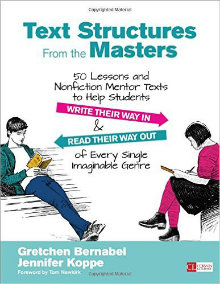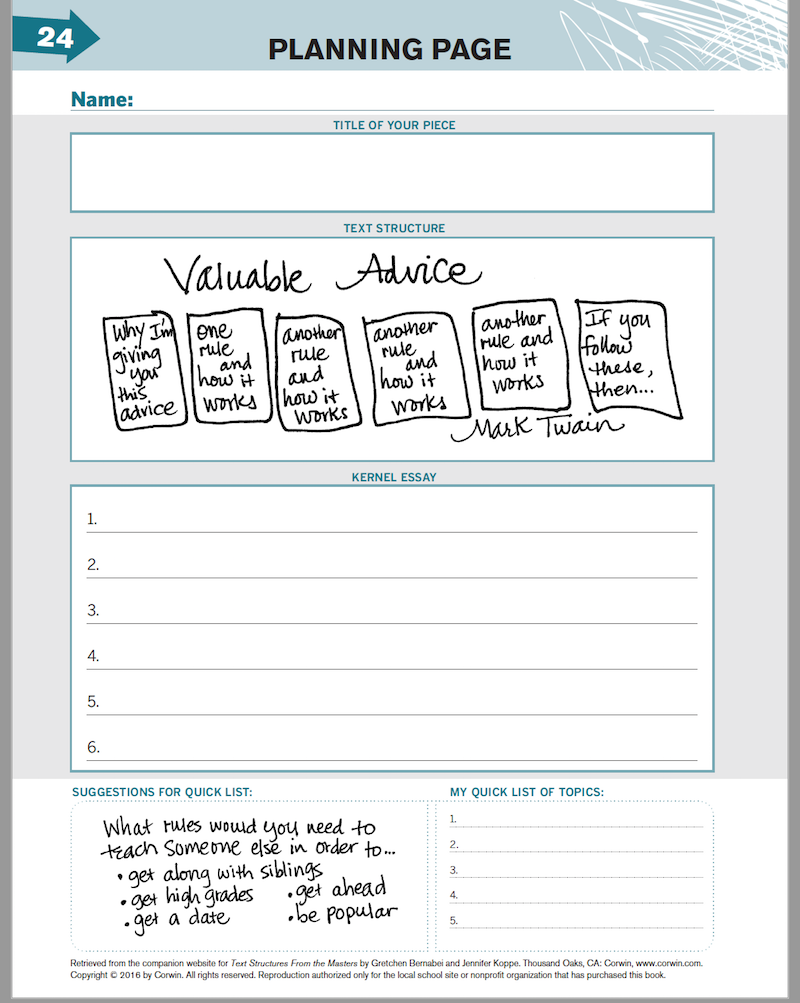Writing and Reading with 50 Mentor Texts
Text Structures From the Masters: 50 Lessons and Nonfiction Mentor Texts to Help Students Write Their Way In & Read Their Way Out of Every Single Imaginable Genre
By Gretchen Bernabei and Jennifer Koppe
(Corwin Literacy, 2016 – Learn more)
Reviewed by Anne Anderson

Educators Gretchen Bernabei and Jennifer Koppe did the hard work for teachers of grades 6–10 when they collected 50 mentor texts and created an easy-to-follow lesson structure for each.

Here is a sampling of the universal messages found in the following historical documents: (p.xx)
| Historical Document | The Itch |
| JFK’s Berlin Speech | To say, “I feel your pain.” |
| FDR’s Pearl Harbor message | To pick up the pieces |
| JFK’s inaugural address | To give a pep talk |
| Mayflower Compact | To make a team promise |
| Henry James letter | To comfort a friend in pain |
| Indians of the Six Nations letter | To say, “No, thank you.” |
| Lincoln’s second inaugural address | To say, “We’re both wrong; we’re both right.” |
| Emancipation Proclamation | To explain a controversial decision |
| MacArthur’s farewell speech | To give parting advice to your replacement |
| Scott Carpenter’s letter from dad | To say “Bon Voyage” |
| Declaration of Independence | To craft a problem-solution message |
| Gettysburg Address | To reflect at a milestone moment |
Concise lessons with student samples
Each lesson set is comprised of 4 pages: a planning page, the historical document, and student writing samples.
The planning page contains a series of boxes with phrases that reveal the structure of the mentor text. It helps to think of the text structure as a brief outline of the historical document. On the planning page is a place for students to brainstorm possible topics for later. Never fear! If a student has trouble brainstorming, the authors even include a few suggestions in each lesson.
There is also space for students to create a kernel essay; in other words, students create an essay using the text structure from the mentor text. Students who struggle with writing will benefit from having a step-by-step plan to imitate when creating a kernel essay.
The teacher has the option of ending the lesson with the kernel essay or continuing the lesson to create a formal essay. Any teacher will appreciate the student examples of kernel essays and completed essays.
For ELA and social studies
When using the lesson for reading, Bernabei and Koppe suggest having students read the text structure first. That gives students an idea of what to look for in the document. As they read the document, students mark chunks of text to show the connections to the structure. This prepares students to write a summary sentence for each of the parts of the text structure (outline). The authors call this process kernelizing the text.
Text Structures From the Masters is a good investment! It will become a valuable resource for teachers of English and/or social studies since the lessons may be used for both writing or reading.
Downloadable planning pages, text structures, and other resources are available at https://resources.corwin.com/textstructures
Anne Anderson is currently an Educational Consultant known for her practical ideas and engaging workshops. Anne’s goal is to help teachers help students. Her positive approach and sense of humor bring encouragement to her audiences. Anne seeks to provide educators with practical solutions to teaching and learning problems. Visit her website www.AnneAndersonEdu.com and subscribe to her bi-monthly newsletter Spotlight on Success.




































